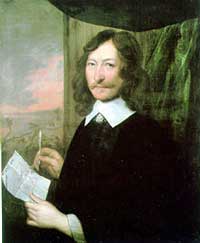 William Lilly
William Lilly1 May 1602, 2:00 AM
Diseworth, England
Placidus Houses, True Node
Geocentric, Tropical
(Source Notes)
William Lilly, artist unknown
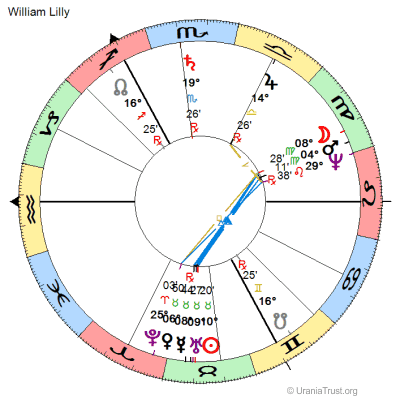
For many centuries astrology was part of a larger body of knowledge called natural philosophy (or 'science'). Among universities, 'scientific' groups and communities, it was generally accepted that a system of correspondences existed between Heaven and Earth. Astrology was studied at universities and "aroused no conflict in the heart of the student."1 Although the Church was somewhat critical of Astrology2, there was no doubt in the minds of many that "God had placed the stars in the heavens as signposts to man's destiny.." 3
Shakespeare, for example, made frequent references to astrology in his poems and plays. John Dee set the date for Elizabeth I's coronation. Tycho Brahe (1546-1601), was an astronomer and alchemist. Johannes Kepler (1571-1630), a key figure in the 17th century 'scientific revolution,' was a mathematician, astronomer and astrologer. Sir Isaac Newton (1642-1727), the great English mathematician, was an astronomer, who did much to clarify the knowledge of planetary motion. Newton himself appears to have had some knowledge of alchemy (which implies an understanding of astrological symbolism). William Lilly had a remarkable influence on his time, likewise Elias Ashmole, who gave astrological advice to King Charles II during the Restoration.
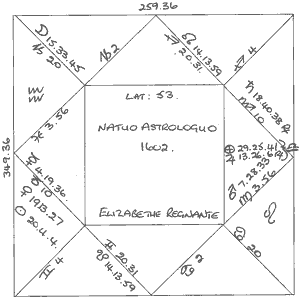 From The Nativity of William Lilly by Sue Ward, from Lilly's unpublished papers.
From The Nativity of William Lilly by Sue Ward, from Lilly's unpublished papers.Nevertheless, there has been a distinct lack of interest in the subject by modern historians and other scholars. Some have written on an aspect of history which involves astrology, but very few have made it a "central scholarly concern". Notable exceptions include Lynn Thorndike, Ellic Howe, Patrick Curry, Nicholas Campion, David Pingree, Otto Neugebauer, Lester Ness and David Brown. (I refer the reader to a more complete listing on Lester Ness's website).4
A L Rowse's examination of the papers of Simon Forman (an Elizabethan physician and astrologer) is also of great interest.5 The History of Astrology Day organised by Annabella Kitson at the Astrological Lodge of London is a highlight in the modern astrological calendar.6
Astrology was extremely popular in the 16th and 17th centuries, although in England there was a lack of important astrological writings until the 17th century, perhaps due to the "malice of the clergy" or the "servile fear" of astrologers, who were uncertain about their legal status.7 Amongst the growing number of amateur and professionals, one name stands out, that of William Lilly, probably the most acclaimed astrologer of his time. The flood of astrological publications from the 1640s onward, as well as the success of Lilly and other astrologers, brought to astrology a "greater vigour, confidence and assertiveness, and (paradoxically) a new respectability."8
Dedicated to his great friend Elias Ashmole, William Lilly wrote his autobiography at Hersham, in the Parish of Walton-upon-Thames, when he was 66 years of age. Lilly tells us that he was born on May 1st 1602 in Diseworth, seven miles south of Derby, where his family had lived for many generations as yeomen, but the freehold land and houses had been sold by his grandfather and father; so his family had to depend "wholly upon a college lease." At that particular time, none of the local farmers educated their sons, apart from his grandfather (Robert Lilly), who sent his younger son to Cambridge. It would appear that Lilly's education was his mother's idea, perhaps as a result of seeing Lilly's father's "back-slidings in the world, and no hopes by plain husbandry to recruit a decayed estate..."9
In 1613, Lilly went to Ashby-de-la-Zouch, to be taught by John Brinsley, a strict Puritan "not conformable wholly to the ceremonies of the Church of England10. Here, Lilly had "the rudiments of a classical education" 11 Lilly's mother died when he was seventeen and the following year, John Brinsley was forced to give up his teaching post, possibly because he was a great friend of the Vicar of Ashby, Arthur Hildersham, a famous Puritan, intended for the Roman Catholic priesthood (but apparently disinherited because of his conversion to Protestantism).12
In the same year, his father's poverty forced William to leave school and go home, where he lived frugally, teaching for about three months at the local school. Unlike his peers, Lilly's father could not afford to send him to Cambridge. Fortunately, his father's attorney, Samuel Smatty, arranged for Lilly to go to London, where a gentleman and his wife required the services of an educated young man. Lilly tells us that his father was "very willing to be rid of me, for I could not work, drive the plough, or endure any country labour; my father oft would say, I was good for nothing."13?
His master's name was Gilbert Wright, who lived at the Corner House on the Strand. He was a man of "excellent natural parts" but could neither read nor write: he lived on his annual rents and had no profession.14 Wright later became Lord Keeper to Sir Thomas Egerton, the Lord Chancellor, who recommended him to the company of Salters in London. In 1625 at the time of the plague, Wright left Lilly in charge of the London house when he moved to the country. After his death in 1627, Lilly sorted out Wright's affairs and later married Wright's wealthy widow Ellen Whitehaire. This was a happy marriage.
Lilly was accepted as a member of the Salter's Company and in 1632 was introduced to an astrologer, John Evans, who took Lilly as a pupil. They parted company when Evans misrepresented the astrological facts to a client in order to please her. In 1633 Mrs Lilly died, leaving him £1000. Lilly bought a part share of thirteen houses in the Strand, as well as the lease on the Corner House. The Question relating to this transaction is included in Lilly's Christian Astrology. The astrological testimony is mostly inauspicious, Lilly admitting to the reader that he had a "hard bargaine". From this point onwards, it is clear that Lilly is starting to build an estate and a small fortune. Naylor suggests that Lilly, through ".. judicious marriages and property investments acquired a bourgeois status of moderate prosperity." 15
Lilly second marriage to Jane Rowley in 1634 did not turn out happily, although it lasted for twenty years. Lilly moved to Herhsam near Esher in 1636. He hadn't been well, or perhaps city life was difficult for anyone with Puritan sympathies. He returned to London about five years later, where he worked as a professional astrologer: the great and the lowly of 17th century London flocking to his Corner House on the Strand. Examples of the Questions (horary charts) which he set up for his clients are included in Christian Astrology. His clients included Bulstrode Whitelocke (later to become Keeper of the Great Seal). He introduced Lilly to Denzil Holles, Sir Philip Stapleton, Robert Reynolds, Sir Robert Pye and Sir Christopher Wray.16 It is believed that Lilly, at his peak, was drawing up at least two thousand charts a year. With the Civil War underway in 1642, he was also building up his library, mostly Latin works printed in Europe.
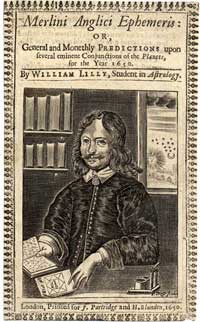 William Lilly's Merlinus Anglicus Ephemeris, 1650
William Lilly's Merlinus Anglicus Ephemeris, 1650In April 1644, Lilly published his first almanac Merlinus Anglicus Junior (he produced an almanac every year thereafter until his death). Later that year he published England's Propheticall Merline, where he makes predictions relating to the recent conjunction of Jupiter and Saturn. Lilly was correct in his forecast of the Great Plague of 1665 and the Great Fire in 1666. The latter involved him in a summons from the House of Commons on 26th October 1666. They appeared to accept the Plague as an Act of God, but felt he was somehow implicated in regard to his prediction about the Great Fire. However, Lilly (with help from Elias Ashmole), escaped conviction.
In August 1644 Lilly's published A Prophesy of the White King and Dreadfull Dead Man Explained (its first printing sold out), where he predicts the death of a King and encourages Parliament to hope for victory. A Royalist defeat (at Marston Moor) had happened while this publication was still at the printers.
In the Starry Messenger Lilly predicts disaster to the King due to the "three suns" seen in London on his birthday. As the Starry Messenger was being read in London, news came of the King's catastrophic defeat at Naseby. With the success of his almanacs came the inevitable attacks, especially from George Wharton who spoke of him as "that Jugling Wizard William Lilly, the States Figure-Flinger Generall, a fellow made up of nothing but Mischiefe, Tautologies and Barbarism.."17
Lilly's role as creator of propaganda was extremely important during the Civil War: a favourable prediction from Lilly was said to be worth more than half a dozen regiments. Lilly claimed that God favoured the Parliamentary cause, although Royalists like George Wharton made the same claim. A paper war of astrological pamphlets and almanacs commenced, which appeared to run parallel to the one on the battlefields.
In his Anglicus of 1645 Lilly himself says
...when we have probable hopes of good successe before hand promised us, it might encourage our Souldiers to attempt greater actions: If the Heavens be averse, more caution must be had.
In Astrology and the Seventeenth Century Mind, Ann Geneva claims that in reality, Lilly was an "artful dodger": if he "found astrological tradition wanting, he did not hesitate to develop a new methodology using existing astrological formulations." Lilly exploited his astrological knowledge "to deploy astrology's entire arsenal in justifying the defeat and beheading of England's anointed sovereign, King Charles I." 18
Geneva contends that Lilly was a committed Parliamentarian from the outset of his writings. However, because of his dual patronage19, and his belief in a Royalist victory (especially before the Battle of Naseby in 1645) Lilly made sure that the most forceful of his anti-monarchical predictions were encoded in astrological ciphers.20 Lilly's most effective weapon was the King's Nativity, which he used to "foreshadow doom".21 We are told that Lilly was gunning for Charles from the beginning, despite his "often cited autobiographical disclaimer that he continued a Royalist until 1645". 22
William Lilly's role as propagandist in the Civil War is certainly a matter worthy of debate, but, equally, the way in which astrological symbolism is evaluated in Ann Geneva's book, deserves closer scrutiny.23 Geneva accepts that "One must... come to terms with some astrological technicalities ..." but also tells the reader:
With the exception of Lilly's famous prediction of the battle of Naseby, which consolidated his fame, we will ignore prophetic tallies from either side, since even speculation in this area presupposes a kind of credulity. 24
Although Lilly's sympathies lay with the Parliamentarians, he was also consulted by politicians, soldiers and Royalists (Lady Jane Whorewood was believed to have sought his advice on two or three occasions in regard to the King's escape from imprisonment). It is also clear that Lilly had an overwhelming dislike for the Presbyterians, who were totally opposed to astrology.
Lilly's remarkable book, Christian Astrology, modestly treated in Three Books, over 800 pages in length, was published in 1647 and raised him to the level of serious astrological scholar. This was the first astrology textbook to be written in English, rather than Latin, and remains his major published work, from which he taught his students.
In 1646 Lilly met Elias Eshmole, who became perhaps his closest friend. Elias Ashmole (1617-1692), antiquary, solicitor, Royalist and historian, was a remarkable man and according to Naylor, a "wonderfully cohesive influence in 17th century London and Oxford." His lived during the time of the Civil War, the Protectorate of Cromwell and the Restoration. He was a graduate of Brazenose College, Oxford, sponsor of the Ashmolean Museum and Treasurer of Manuscripts. He was also a close friend of Sir George Wharton, who shared Ashmole's enthusiasm for the Royalist cause.25
Through Ashmole's diary we learn about The Society of Astrologers in London. Ashmole was elected its steward in August 1650. Ashmole's biographer, C H Josten, writes that on three occasions in 1673, Ashmole's astrological advice was sought on political questions from the Lord High Treasurer, Lord Clifford. Ashmole's advice was also requested by Charles II in regard to his future relations with Parliament. Ashmole in turn, apparently sought Lilly's advice on such matters. Their advice was based on Questions (horary charts), Nativities and Revolutions.26 Annabella Kitson tells us that they were close observers of events, Ashmole from his Royalist stance and Lilly from his "ambiguous parliamentarian point of view". Their differences had not upset their relationship over the years, with Lilly's expertise "mediated to the court by the suave and acceptable Ashmole."27 Lilly himself was sent a present by the King of Sweden. The King was grateful for Lilly's support in encouraging an English alliance with Sweden. He subsequently had Lilly's almanacs translated into Swedish and German for local distribution.28
During the Restoration, both John Aubrey and Elias Ashmole helped forge a link between the astrological and the scientific world. Both were friends of leading astrologers and both were active members of the Royal Society (which was rather sceptical about astrology). In an almanac, John Gadbury expressed the hope that one day the Royal Society would adopt a more favourable attitude towards astrology. Other links between these two worlds were provided by Jonas Moore and George Wharton. Capp tells us that this "network of friendship, patronage and sympathetic interest extended much further.." to people such as Henry Coley, Sir John Hoskins and John Evelyn. Ashmole's collection of the manuscripts of John Dee was of particular interest to Sir John Robartes (Earl of Truro).29 This is especially interesting to the author, who was recently given access to a collection of books at Lanhydrock House in Cornwall. Amongst many rare publications was an original Christian Astrology. John Robartes, also a supporter of the Parliamentarians, was a major influence in the building up of a library at Lanhydrock House.30
Other names of the time are William Ramesey "..student in astrology, physick, and the most heavenly of sublime sciences.." John Partridge and John Booker, (a Parliamentarian, who became the official Licenser of Mathematical and Astrological Books). At this time, "Officialdom had not yet reached the dividing line between astrology and orthodox science."31
The Society of Astrologers was busy making forecasts about their country, the world, the weather and the likelihood of disease. The Society also organized Astrological Feasts, which were held for many years. Over forty astrologers, many of whom disliked each other, were willing to suspend hostilities at the time of the feast.32 On the fringe of these groups were eccentrics, such as the Rosicrucians, one of the most famous being Robert Flood (1574-1637) an engineer and physician, who used astrology. John Dryden, Poet Laureate and Historiographer Royal (1670) also had an interest and skill in astrology.33 In 1661 Jean Baptiste Morin's Astrologia Gallica was published in Paris. Morin was Royal Professor of Mathematics at Paris. His Astrologia, enormous in length, was of great interest to Lilly, more particularly the details relating to astrology in the treatment of illness. Morin reminds his readers that the Roman Catholic Church had never disapproved of astrology as a means of diagnosing and treating disease.34
Following the end of the Civil War and the execution of the King in 1649, many were convinced "that a new world was opening up, and even that God himself would soon return to earth to rule in person."35 During Cromwell's Protectorate, Lilly's success continued with sales of his almanacs reaching 30,000. But he eventually became disillusioned with the Parliamentarians. Lilly later recalls that by the time of his 1652 edition of Anglicus, his "soul began to loathe the very name of Parliament."36 This was one of the earliest publications to reflect a growing distaste for Parliament. He was imprisoned for almost a fortnight because of his remarks.
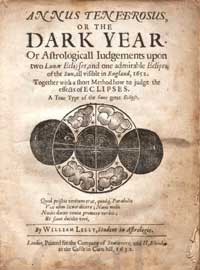 William Lilly's Annus Tenebrosus or the Dark Year, 1652
William Lilly's Annus Tenebrosus or the Dark Year, 1652Lilly's Annus Tenebrosus or the Dark Year was written in 1652 where he discusses the effects of Eclipses. In the same year, Lilly brought Hurst Wood, at Hersham in the parish of Walton-upon-Thames, standing in 18 acres of parkland. Many private and political attacks were made against him in the 1650's, mostly from colleagues or fellow astrologers who were probably jealous of his success. Lilly's second wife Jane died in 1654 and he married for a third time to Ruth Needham, with whom he was very happy.
After Oliver Cromwell's death in 1658, the authority of the Protectorate started to fall apart and from about 1660 "astrology began a long and disastrous fall from favour."37 The Restoration of King Charles II in 1660 was probably a difficult time for Lilly, who had been strongly identified with the Parliamentarian cause. Fortunately, he had a number of influential clients and friends, who were of particular help when he was summoned to appear before a parliamentary committee in 1660, in regard to a claim that he knew who had executed Charles I. He was arrested again in 1661, but Lilly made peace with the new regime and pledged his allegiance to Charles II. Following the reintroduction of censorship, Lilly's almanac sales decreased and his private practice declined in the 1660's. Curry tells us that in the minds of the middle and upper classes, astrologers were associated with "the chaos and sedition of the Civil War period."38
By 1665 Lilly was living permanently in Hersham, having acquired an assistant and friend Henry Coley, thirty years younger than himself, in the late 1660's. His interest in medicine grew and he was granted a licence to practice "physic". In 1675 he engaged in the last of his great public altercations with John Gadbury. The following year he wrote the Foreword to Coley's Clavis Astrologiae Elimata. Coley had also been working on a translation of the considerations & aphorisms of Bonatti and Cardan, which was published under Lilly's name. The 1682 almanac was the last to which Lilly had made any significant contribution. He died on June 8 1681 and was buried in Walton Church on June 10th. Ashmole arranged his funeral and set up a black marble stone. Ashmole bought Lilly's library from Ruth for £50 He had also bought John Booker's library. Both libraries are in the Ashmolean Museum.
The 17th century closed with a more critical approach to science, which may have been partly responsible for the demise of astrology as "an intellectually respectable explanatory system.."39 Perhaps it was not possible to reconcile new scientific discoveries with old astrological theory? It has been suggested that the scientists were not astrology's most prominent critics. According to Capp, "Mr Thomas has observed that 'the clergy and the satirists chased it [astrology] into the grave, but the scientists were unrepresented at the funeral' "40 Is the inscription at Greenwich Observatory an early indication of changing times? John Flamsteed, Astronomer Royal, writes the words Risum Teneatis Amici! (can you help but laugh friends), appended to a horoscope cast for the inaugural moment (the laying of the foundation stone) on August 10th 1675.41
In view of its influence upon society, the extent to which astrology has been neglected by historians is quite remarkable. Fortunately for astrologers today, facsimile editions of Christian Astrology, provided by the late Olivia Barclay in 1984, facilitated a republication of his masterpiece and a consequent revival of traditional astrology. Christian Astrology remains the standard text for all students of traditional astrology in the twenty first century and forms the basis of Olivia Barclay's Qualifying Horary Practitioner correspondence course, bequeathed to the author in 2001.
© Barbara Dunn 2010
Barbara Dunn
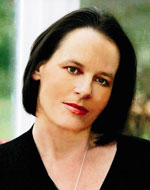
Barbara Dunn on behalf of the Qualified Horary Practitioner (QHP) was recently awarded a doctoral studentship from the Wellcome Trust for research into medical astrology at Exeter University. Barbara has enjoyed a long career as a media astrologer, is Principal of the QHP, and author of Horary Astrology Re-Examined.
General information in this essay
William Lilly. Autobiography. William Lilly's History of His Life and Times. Project Gutenberg EBook.
Derek Parker, Familiar to All: William Lilly and Astrology in the Seventeenth Century, Cape, London. 1973
References
- P Naylor, Astrology: An Historical Examination, Robert Maxwell, Pergamon Press Ltd, London W1 1967 p 90
- Annabella Kitson, ed. History and Astrology, Clio and Urania confer. Unwin Hyman, London, 1989. p180. Kitson tells us that Electional Astrology was not criticized by the church because it was not deterministic in its doctrine, but was an exercise of free will.
- P Naylor p 87
- Lester Ness website: Historians of Astrology (source at the time of writing: http://cura.free.fr/xxv/25ness.html)
- A L Rowse a Cornish historian and friend of the author's late father.
- The History of Astrology Day still takes place every year, under the auspices of The Astrological Lodge of London and its chair Kim Farnell.
- Bernard Capp. Astrology & the Popular Press, English Almanacs 1500-1800, Faber and Faber Ltd, London 1979 Capp citing Nicholas Fiske pp181-182
- Capp p 182
- Lilly, William. Autobiography. William Lilly's History of His Life and Times. The Project Gutenberg EBook.
- ibid
- Naylor p 94
- Derek Parker. Familiar to All: William Lilly and Astrology in the Seventeenth Century, London, Cape, 1973. p 30
- Lilly. Autobiography.
- ibid
- Naylor p 94
- Parker p 88
- Parker p 103
- Ann Geneva, Astrology and the Seventeenth Century Mind, William Lilly and the Language of the Stars. Manchester University Press, UK, 1995 p184 and p198
- Ann Geneva pp 56-57 Lilly's claim to have been more "Cavalier than Roundhead" in his early publications, has, according to Ann Geneva been accepted at face value by Keith Thomas, Bernard Capp and Harry Rusche. Geneva claims that Lilly had many reasons for "maintaining a pose of neutrality and posture of belief in polity". Among these reasons is the fact that from 1643-1652 the Royalist, William Pennington, was Lilly's patron. Simultaneously, in 1643, the Parliamentary leader, Bulstrode Whitelocke, gave Lilly his patronage, when Lilly successfully predicted his recovery from an illness.
- ibid p 57
- ibid p 195
- ibid p 198
- I have been unable to substantiate a number of claims made by Ann Geneva in regard to Lilly's misuse of astrological symbolism. I include just a few:
- p 181 the significations of Tenth House for a King and the Moon for Parliament are well documented in traditional sources.
- pp 185-190 planets or luminaries not beholding the ascendant (through an aspect or through antiscia) were generally thought to be enemies of the ascendant. (see Horary Astrology Re-Examined: The Possibility or Impossibility of the Matter Propounded, by the author)
- pp 191,193 the role of dispositors is not a piece of "fancy footwork", but a well known traditional astrological technique. Mars, tenth house ruler (the King) is in the first house in Aquarius, disposed of by Saturn ruler of the ascendant (Parliament). A planet or luminary when located in a particular house, is under the power of the ruler (or owner), of that house.
- p 76 " ..the sky was divided arbitrarily into twelve equal 30 degree portions.." There was nothing arbitrary about house division.
- p 62 the weighing up of astrological testimony (indications) is the same, no matter what type of figure is under consideration.
- p 160 there is confusion about the correct Nativity for William Lilly (see reference to Sue Ward above). The Nativity at the beginning of this essay is from MS Ashm. 394, endorsed by Ashmole and copied by Ashmole. It is believed that this is the correct Nativity, rectified and directed by Lilly himself. In a nocturnal Nativity, such as this, the Moon has rulership over the earth triplicity. Located in Capricorn, therefore, she has dignity through triplicity. She is also correctly placed in a nocturnal chart, above the horizon and in a feminine sign, so acquires further dignity being in her hayyiz.
- ibid preface xvi
- Naylor p 95
- Kitson pp 190-191
- Kitson p 191
- Capp p 85
- Capp pp 188-189
- http://www.bibsocamer.org/BibSite/Pearson/Pearson.pdf The Robartes family lived at Lanhydrock House (near Bodmin in Cornwall) from about 1620. Lanhydrock House was given to the National Trust in 1953.
- Naylor p 98
- Parker pp 163-164
- Naylor pp 98-99
- Parker pp 216-218
- Angela Anderson, An Introduction to Stuart Britain 1603-1714, Hodder & Stoughton, London 1999 p 117
- Capp p 83
- Patrick Curry. Prophecy and Power: Astrology in Early Modern England, Princeton University Press, 1989. p 10
- ibid p 10
- Ann Geneva preface xiv
- Capp p 190
- Naylor pp 87-88
Bibliography
Anderson, Angela. An Introduction to Stuart Britain 1603-1714. Hodder & Stoughton, London 1999.
Capp, Bernard. Astrology & the Popular Press, English Almanacs 1500-1800. Faber and Faber Ltd, London 1979.
Curry, Patrick. Prophecy and Power: Astrology in Early Modern England. Princeton University Press, 1989.
Geneva, Ann. Astrology and the Seventeenth Century Mind, William Lilly and the Language of the Stars. Manchester University Press, UK, 1995.
Kitson, Annabella. ed. History and Astrology, Clio and Urania confer. Unwin Hyman, London, 1989.
Lilly, William. Christian Astrology. Tho. Brudenell for John Partridge and Humphrey Blunden, London, 1647.
Christian Astrology. Regulus Publishing, 1984.
Lilly, William. Autobiography. William Lilly's History of His Life and Times. The Project Gutenberg EBook.
Naylor, P I H. Astrology: An Historical Examination. Robert Maxwell, Pergamon Press Ltd, London W1 1967.
Parker, Derek. Familiar to All: William Lilly and Astrology in the Seventeenth Century. London, Cape, 1973.
Thorndike, Lynn. A History of Magic and Experimental Science. The Sixteenth Century Columbia University Press, New York, 1941.
